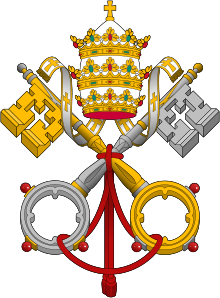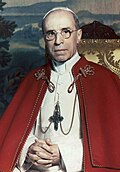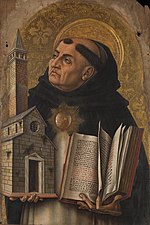
Back بوابة:الكنيسة الرومانية الكاثوليكية Arabic Уикипедия:Светци Bulgarian Portalo:Katolika Eklezio Esperanto Portal:Iglesia católica Spanish Portail:Catholicisme French Portál:Katolicizmus Hungarian Portale:Cattolicesimo Italian Portal:Katolik Malay Portal:Den katolske kirke NB Portal:Katolicyzm Polish
Introduction The Catholic Church, also known as the Roman Catholic Church, is the largest Christian church, with 1.28 to 1.39 billion baptized Catholics worldwide as of 2024. It is among the world's oldest and largest international institutions and has played a prominent role in the history and development of Western civilization. The church consists of 24 sui iuris churches, including the Latin Church and 23 Eastern Catholic Churches, which comprise almost 3,500 dioceses and eparchies around the world. The pope, who is the bishop of Rome, is the chief pastor of the church. The Diocese of Rome, known as the Holy See, is the central governing authority of the church. The administrative body of the Holy See, the Roman Curia, has its principal offices in Vatican City, which is a small, independent city-state and enclave within the city of Rome, of which the pope is head of state and absolute elective monarch. The core beliefs of Catholicism are found in the Nicene Creed. The Catholic Church teaches that it is the one, holy, catholic and apostolic church founded by Jesus Christ in his Great Commission, that its bishops are the successors of Christ's apostles, and that the pope is the successor to Saint Peter, upon whom primacy was conferred by Jesus Christ. It maintains that it practises the original Christian faith taught by the apostles, preserving the faith infallibly through scripture and sacred tradition as authentically interpreted through the magisterium of the church. The Roman Rite and others of the Latin Church, the Eastern Catholic liturgies, and institutes such as mendicant orders, enclosed monastic orders and third orders reflect a variety of theological and spiritual emphases in the church. Of its seven sacraments, the Eucharist is the principal one, celebrated liturgically in the Mass. The church teaches that through consecration by a priest, the sacrificial bread and wine become the body and blood of Christ. The Virgin Mary is venerated as the Perpetual Virgin, Mother of God, and Queen of Heaven; she is honoured in dogmas and devotions. Catholic social teaching emphasizes voluntary support for the sick, the poor, and the afflicted through the corporal and spiritual works of mercy. The Catholic Church operates tens of thousands of Catholic schools, universities and colleges, hospitals, and orphanages around the world, and is the largest non-government provider of education and health care in the world. Among its other social services are numerous charitable and humanitarian organizations. (Full article...) Selected article
 Our Lady of Guadalupe (Spanish: Nuestra Señora de Guadalupe, Nahuatl: Nicān Mopōhua), also called the Virgin of Guadalupe (Spanish: Virgen de Guadalupe) is a 16th century Roman Catholic icon depicting an apparition of the Virgin Mary. It is Mexico's most beloved religious and cultural image. Our Lady of Guadalupe is known in Mexico as "La Virgen Morena", which means "The brown-skinned Virgin". Our Lady of Guadalupe's feast day is celebrated on December 12, commemorating the account of her appearances to Saint Juan Diego on the hill of Tepeyac near Mexico City from December 9 through December 12, 1531.The Virgin of Guadalupe is a cultural symbol of significant importance to the Mexican identity.The Basilica of Our Lady of Guadalupe in Mexico City is the second most visited Roman catholic shrine on the world after the Basilica of Saint Peter in the Vatican.The image of Our Lady of Guadalupe is often read as a coded image. Miguel Sanchez, the author of the 1648 tract Imagen de la Virgen María, described the Virgin's image as the Woman of the Apocalypse from the New Testament's Revelation 12:1: "arrayed with the sun, and the moon under her feet, and upon her head a crown of twelve stars."
Selected image
 Credit: Diliff St. Vitus Cathedral (Czech: Katedrála svatého Víta) is a Roman Catholic cathedral in Prague, Czech Republic, and the seat of the Archbishop of Prague. The full name of the cathedral is St. Vitus, St. Wenceslas and St. Adalbert Cathedral. Located within Prague Castle and containing the tombs of many Bohemian kings, this cathedral is an excellent example of Gothic architecture and is the biggest and most important church in the country. Selected biography
 Pope Pius XII (Latin: Pius PP. XII; Italian: Pio XII), born Eugenio Maria Giuseppe Giovanni Pacelli (March 2, 1876 – October 9, 1958), reigned as the 260th pope, the head of the Roman Catholic Church and sovereign of Vatican City, from March 2, 1939 until his death. Before election to the papacy, Pacelli served as secretary of the Department of Extraordinary Ecclesiastical Affairs, papal nuncio and cardinal secretary of state, in which roles he worked to conclude treaties with European nations, most notably the Reichskonkordat with Germany. His leadership of the Catholic Church during World War II and The Holocaust remains the subject of continued historical controversy. After the war, Pius XII contributed to the rebuilding of Europe, and advocated peace and reconciliation, including lenient policies toward vanquished nations and the unification of Europe. The Church, flourishing in the West, experienced severe persecution and mass deportations of Catholic clergy in Eastern Europe and China. Did you know...

Related portalsFeast Day of January 28
Selected quote

News
SubcategoriesTopics
The Holy Bible:
Particular Churches (grouped by liturgical rite):
Things you can do
External resourcesWikiProjectsAssociated WikimediaThe following Wikimedia Foundation sister projects provide more on this subject:
Discover Wikipedia using portals |
































